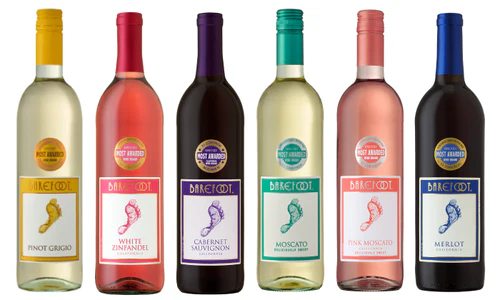Every great entrepreneurial story has a moment when everything just clicks—a realization that you’re on to something bigger than you ever imagined.
For Barefoot Wine founders Michael Houlihan and Bonnie Harvey, this came from two key insights: brand positioning and customer research.
I recently listened to their interview on the How I Built This podcast, and what struck me was how Barefoot Wine wasn’t just a product of their passion for wine but also an example of the power of understanding your market and positioning your brand to stand out from the crowd.
Finding Their Place in a Crowded Market
When Barefoot launched in the 1980s, the U.S. wine industry was well-established.
In fact, there was a sense that if you were serious about wine, you drank French. American wines, on the other hand, were often viewed as inferior.
To make matters worse, wine had a snob appeal—expensive, sophisticated, and reserved for special occasions. For the average consumer, beer was the everyday go-to, while wine was often seen as out of reach.
This is where Barefoot Wine saw a huge opportunity. They saw a gap between the high-end wines and the casual beer drinkers.
There was room for an everyday wine, something affordable, approachable, and consistent. Their vision was simple: create a wine that’s easy to drink, available year-round, and, most importantly, predictable—no surprises, just a product that delivered every time.

At a time when most winemakers were focused on premium products, Barefoot Wines found a niche for a “cheap and cheerful” table wine that consumers could count on. This wasn’t just luck—it was a brand positioning decision that spoke directly to an underserved audience.
The Power of Knowing Your Customer
But Barefoot’s story isn’t just about filling a gap; it’s also about knowing their customer.
When they first talked to a large retailer about who might buy their wine, they were told something surprising: their ideal customer was a 35-year-old woman.
For her, wine wasn’t a luxury; it was another staple alongside milk, eggs, and bread in the grocery cart. It wasn’t something to be fussed over; it was simply a reliable choice for a glass with dinner.
This insight shaped Barefoot’s actions moving forward. They understood that their target market didn’t want to be impressed by fancy labels or exotic blends. Instead, these consumers valued consistency and convenience.
Barefoot focused on making a product that delivered the same taste every time and making their wine easy to find.
The retailer also told them that the bottle label needed to be eye-catching—visible from four feet away, standing out on a crowded shelf. So, they created a distinctive label (inspired by Bonnie’s foot!) that would grab attention.
What followed was extensive research, confirming what they already suspected: women were the decision-makers when it came to wine purchases.
Barefoot’s branding and marketing efforts were tailored to reflect that, making it easy for their target customer to choose their product over more expensive or unfamiliar options.
Turning Research into Results
With this understanding of their brand and target audience, Barefoot slowly started to build its business.
One of the most interesting aspects of their growth strategy was how they built connections with their target audience through local events.
Without a budget for national or even local ad campaigns, they sponsored community gatherings where they could personally introduce their wine to the people most likely to buy it.
This grassroots marketing approach worked. Despite financial struggles and a long journey to gaining a foothold, Barefoot persevered before it was sold to E. & J. Gallo in 2005.
Lessons from Barefoot Wine
Barefoot Wine’s success highlights two key components of a marketing strategy: brand positioning and customer research.
By discovering an underserved market and deeply understanding their audience’s needs, they created a product and brand that resonated with them personally.
For entrepreneurs and marketers, it is a reminder of the importance of:
- Identifying market gaps: Sometimes, the most successful businesses find and fill a need others have overlooked.
- Knowing your customer: When you understand your audience’s wants, needs, and shopping habits, you can create a product that fits seamlessly into their lives.
- Branding that resonates: It’s not just about making a good product; it’s about ensuring that your brand stands out and is easy to find in a crowded marketplace.
In a world of premium offerings, Barefoot made wine accessible, affordable, and, most importantly, relatable.
And that’s the real power of great brand positioning and customer research.
If you like this content, sign up for my weeky newsletter. If you’re a B2B or SaaS company looking to make sales faster and easier, we should talk. Book a no-obligation discovery call.